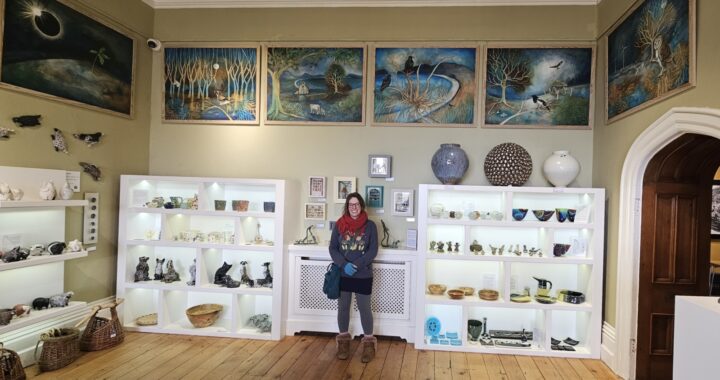
As part of the national CELF project, Plas Glyn-y-Weddw was awarded funding to commission new artwork, leading to the creation of Tess Urbanska's stunning Tree of Life panels. Inspired by Mildred Elsie Eldridge’s Dance of Life (1951–1956), Tess's work brings a contemporary perspective to themes of harmony between humans and nature.
Urbanska, a talented artist from Rhydyclafdy, is deeply influenced by the landscapes and traditions of the Llŷn Peninsula, where she lives. Her work often explores the connection between the natural world and cultural customs, and these themes are vividly expressed in her Tree of Life panels. Eldridge’s Dance of Life mural, which addresses the loss of harmony with nature through industrialization, provided the initial inspiration for Urbanska’s work, which celebrates seasonal rituals and human unity with the earth.
The panels invite viewers into a narrative of joy and connection, echoing Eldridge’s message while adding a unique, modern interpretation that resonates with Wales' cultural heritage.
PANEL 1
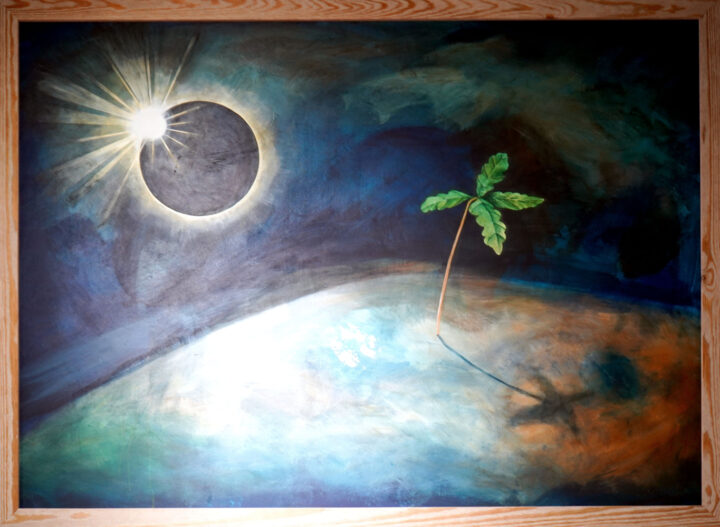
The Tree
Referencing the tree of life. It represents a link to the past, the present and the future. The tree features as a continual symbol in these panels. The roots reach down into the ancient layers of earth, the branches reach up to the heavens.
PANEL 2
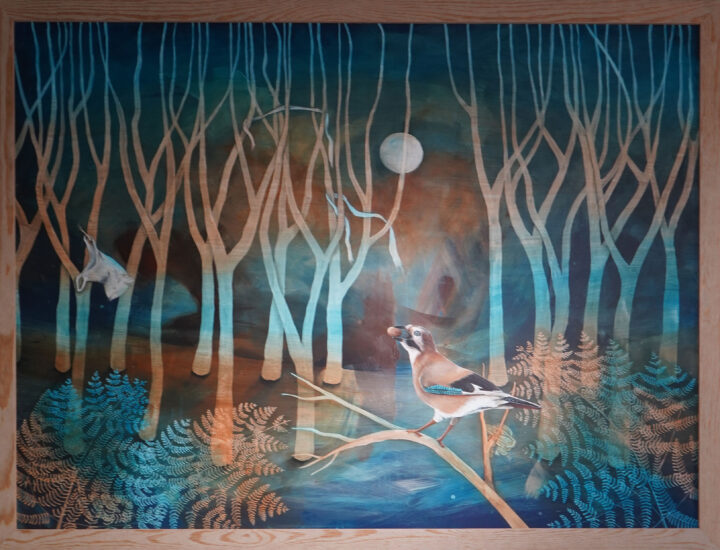
Silver Birch and Birch
Represents new beginnings, protection and renewal. The trees in this panel and the Jay bird are linked to Elsi. The name that was given to her son, Gwydion, (featured in the Mabinogi) means ‘born of trees’, and is associated with nature and woodlands. There is a strong connection to folklore and myth in the landscape of Llŷn. This panel is meant to elicit that feeling of mystery and atmosphere. Like Gwydion, being able to navigate between the natural and supernatural realms.
The Jay
Was an important symbol to Elsi, although I can’t find an answer to why this was, she featured the Jay’s feather in her self-portrait of 1967. Possibly, because of its striking colour, being the most colourful bird of the crow family. In Welsh the Jay is named ‘Sgrech y Coed’ (‘the scream of the woods’) which links to the plastic bag and the detritus tangled in the branches of the woodland, symbolising the effect of man and pollution in these sacred habitats that are home to so much wildlife. Fly-tipping is also a problem that affects some of the woodlands and natural spaces here on Llŷn. In the beak of the Jay it carries an acorn, this is meant to symbolise hope for the future. Jays are considered incredibly important in Britain because they play a crucial role in reforestation and the spread of oak woodlands and rewilding.
PANEL 3

The Trees
A continuity from panel 1 and again reference the cycle of life. The Church (Llanfihangel Bachellaeth) Churches and Chapels are an endemic feature of the Llŷn countryside, with many now privately owned, or sometimes left empty.The Church here represents the past, the leaving behind of old customs that comes with societal change.
The Sheep and Lamb
Represent the disappearing congregations that would once have attended these old religious buildings. The cross on the roof of the church is echoed by the turbine in the background of the landscape. Panel 2 in Elsi’s Dance of Life also features a much larger flock of sheep being fed at troughs, the symbolism of God being the shepherd and feeding the lambs.
The Flock of Birds
Representing a different type of flock, one not necessarily associated with God. What does one flock to now?
PANEL 4
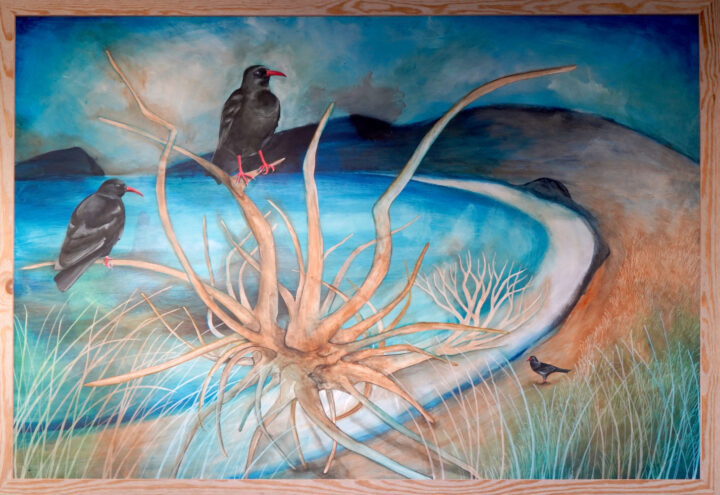
The Tree
The uprooted skeletal tree due to erosion. The death of the tree. ‘The beauty of natural decay’ M.E. Eldridge (Panel 3) Parallels: Skeletal boat = Skeletal tree
The Coastline
Is inspired by the coastline of Llŷn, especially that of Porth Neigwl with views of Rhiw, the home of Elsi and R.S. Thomas in the distance. The area has suffered significant changes due to landslides and coastal erosion, hence the uprooted tree. On a recent visit to their former home at Sarn y Plas, I observed the significant erosion that had affected the land very close to the entrance to their cottage.
Chough Birds
The Chough is the rarest member of the crow family and are coastal birds. They have suffered serious decline in numbers in many areas of the Britain due to loss of habitat and changes in farming practices, over grazing, hunting and egg collecting. The Llŷn Peninsula is an important habitat for Choughs and is designated as a special protection area. Annual counts of Chough take place in the area to identify important habitats and detect population trends.
PANEL 5
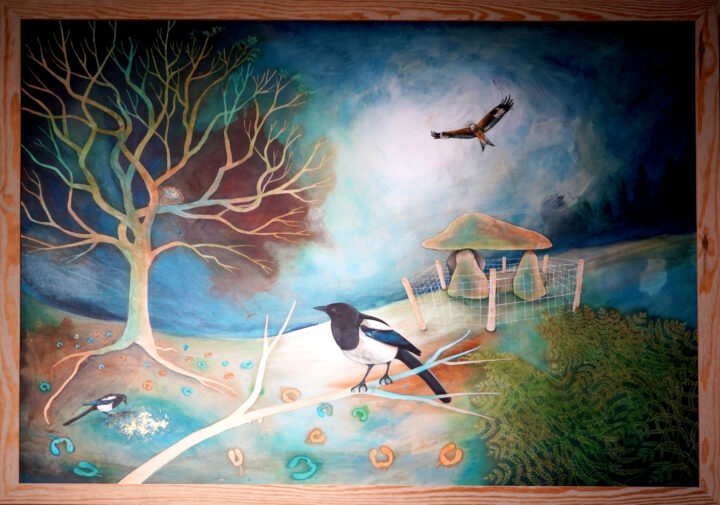
The Tree
Representing the cycle of life, continuity. The eggs in the nest, the sycamore seeds, representing hope for the future.
The Red Kite
Represents the species of bird now commonly seen over the skies of Llŷn. A success story in conservation, of a previously endangered bird. Red Kites became endangered in Britain due to a combination of factors including persecution. They were hunted almost to extinction due to the belief that they were a threat to game birds and domestic animals. As their numbers declined, the Kite’s eggs would become more valuable, which in turn led to an increase in egg collection, which was a further detriment to the species.
The Magpies
A bird often plagued with a bad reputation due to religious narratives and superstitions. Magpies much like the Red Kite have also been persecuted at the behest of man. The magpie was so feared by Victorians that they were hunted mercilessly during the mid-1800’s with a sustained campaign to eradicate them, continuing until the beginning of WWI, causing their numbers to plummet. Still, to this day, many people hold negative superstitions about the Magpie with some believing it has links with the devil.
The Cromlech (Mynydd Cefn Amlwch)
Represents a link to the ancient past and ancient people. Before organised religion as we experience it today, there is a belief that a Cromlech was a tomb for burying the dead and a meeting place for community events and rituals. Neolithic people believed that all elements of nature, such as animals, rivers, mountains and stones, were self-conscious. The Cromlech is inspired by a real place and I chose to include the modern fence as a link to the present day. A modern human structure protecting an ancient human structure. The gold in the earth represents the minerals that can be found there, but also to evoke the many layers of ancient history contained below the surface of the earth, whether it be the remains of a Neolithic burial, Roman/Celtic artifacts etc.
PANEL 6
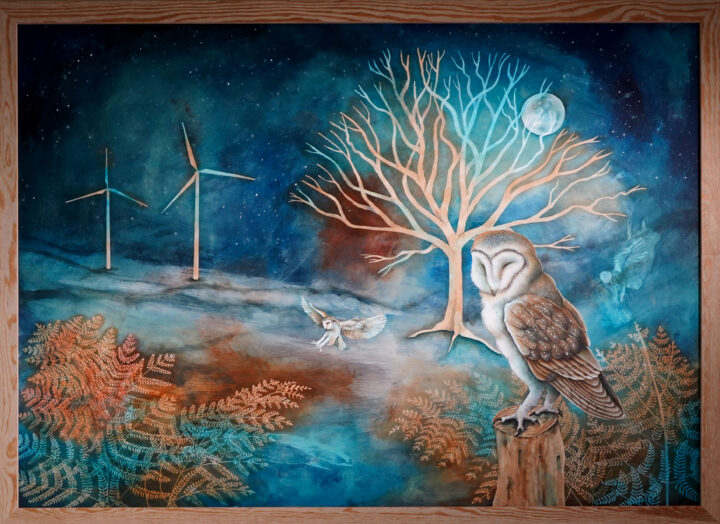
The Oak Sapling
This represents hope and the beginning of the cycle of life, that links back to the acorn in the Jay’s beak in the previous panel. ‘From one small acorn grows a mighty oak’ 14th century proverb.
The Gold
Links back to Panel 4, the treasures below the earth (minerals, ancient artifacts etc.) not just what is above but also below.
The Eclipse
Symbolises things beyond the surface of this planet and the significance of the Sun giving life to everything on earth. During a solar eclipse the sun is momentarily obscured, and darkness falls during the day. Birds cease to sing. This can cause an unnerving experience, combined with fear and awe, an event that might remind us of the clockwork of the universe that humans can’t affect or stop. The word ‘eclipse’ comes from the ancient Greek word meaning ‘abandonment’ with many ancient cultures believing the sun would abandon the Earth.
Wind Turbines
There are a few of these dotted around the Llŷn landscape, one of which I see every day as I drive to and from the studio. Overall, wind turbines have a positive effect that benefits the environment, providing us with clean energy. However, they could be perceived as having an unappealing aesthetic especially here on Llŷn in areas of outstanding natural beauty. There are also a lot of questions raised about their impact on birds and bats. In the first couple of Elsi’s panels, she depicts figures in an Italian landscape dancing and blessing the crops and in some instances placing crosses in the ground. These small crosses reminded me of the turbine I see from a distance on the way to the studio, especially on a non-windy day when it stands still. Although I appreciate that these turbines have absolutely no connection to any kind of religion or ceremonial use, they are a contemporary example of how modern man has mostly moved on from old traditions/blessings using new alternative ways to protect not only the crops and harvests in the short term but the planet as whole in the long term.
The Barn Owls
The Barn Owl represents a link to the past and to the present. One owl in the foreground is pictured with its eyes closed. This is a direct reference to Elsi’s painting ‘Sleeping Barn Owl’ 1961 (not part of the Dance of Life.) The second Owl is pictured hunting in the middle-ground, this represents the present, and links to the past and the cycle of life. The Owls’ exceptional environmental flexibility, having existed in the lands of Llŷn for possibly thousands of years, prospering in a variety of locations available to it. The third Owl is only visible as a spirit, linking back to the previous generations who may have hunted over the same ground.